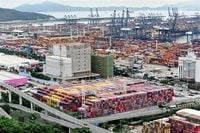In the first four months of 2025, Vietnam's economy has demonstrated significant resilience and growth, with a total import and export turnover estimated at $276.89 billion, marking a 15.7% increase compared to the same period last year. This robust performance is largely attributed to a surge in exports, which reached $140.34 billion, up 13% year-on-year, while imports totaled $136.55 billion, rising by 18.6%.
The trade balance remains positive, with a surplus of $3.79 billion recorded in the first four months, although this is a decrease from the $9.06 billion surplus achieved in the same period in 2024. Notably, the domestic economic sector has shown impressive growth, contributing $40.74 billion to exports, an increase of 18.1% and accounting for 29% of total export turnover.
According to the General Statistics Office, in April 2025 alone, Vietnam's total import and export turnover reached $74.32 billion. This figure represents a slight decrease of 1.4% from March 2025 but a remarkable increase of 21.3% compared to April 2024. The export turnover for April was $37.45 billion, a decrease of 2.8% from the previous month, primarily due to a 6% drop in the foreign direct investment (FDI) sector. However, the domestic sector achieved a growth rate of 5.2%, bringing in $11.66 billion.
In terms of sectors, the processed industrial goods continue to dominate, with a turnover of $123.71 billion, accounting for 88.2% of total exports. Agricultural and forestry products contributed $12.39 billion (8.8%), seafood reached $3.21 billion (2.3%), and fuels and minerals accounted for $1.03 billion (0.7%). This trend highlights Vietnam's ongoing commitment to deep processing industries, while still maintaining a strong position for agricultural and fishery products in the global value chain.
The Index of Industrial Production (IIP) for April 2025 is estimated to have increased by 1.4% from the previous month and by 8.9% compared to April 2024. The manufacturing sector experienced a significant increase of 10.8% year-on-year, while the water supply, management and waste treatment sector rose by 7.6%. Electricity production and distribution saw a 4.6% increase; however, the mining sector experienced a decline of 4.2%.
Over the first four months of 2025, the overall IIP is estimated to have risen by 8.4% compared to the same period last year, with the manufacturing sector contributing 8.5 percentage points to this increase. The electricity production sector added 0.5 percentage points, while the water supply sector contributed 0.1 percentage points. Conversely, the mining sector's decline reduced the overall growth by 0.7 percentage points.
Key industrial products have also shown impressive growth. For instance, the production of motor vehicles surged by 35.1%, and the production of leather and related products rose by 16.7%. Other notable increases include rubber and plastic products (16.4%), apparel (15.7%), and wood processing (15.2%). In contrast, the IIP for crude oil and natural gas extraction saw a significant decline of 10.9%, while the production of electrical equipment decreased by 6.2%.
The employment landscape in the industrial sector has also seen positive developments. As of April 1, 2025, the number of employees working in industrial enterprises increased by 0.7% from the previous month and by 5.1% compared to the same time last year. The state-owned enterprises maintained their employment levels, while foreign-invested enterprises saw a 0.8% increase, and non-state enterprises also grew by 0.8%.
In terms of import dynamics, the import turnover for April 2025 was $36.87 billion, nearly unchanged from March. The domestic sector saw a slight increase of 3.6%, while the FDI sector experienced a decrease of 2.2%. Compared to April 2024, imports increased by 22.9%, with the domestic sector rising by 26% and the FDI sector by 21%.
There were 25 items with import values exceeding $1 billion, including two items surpassing the $5 billion mark. The production materials category dominated imports, accounting for 93.9% of total imports, with machinery, equipment, tools, and spare parts making up 50.6%, and raw materials comprising 43.3%. Consumer goods accounted for a modest 6.1% of imports, reflecting a trend towards prioritizing production over consumption.
Trade data also reveals that the United States remains Vietnam's largest export partner, with a turnover of $43.4 billion in the first four months of 2025, resulting in a significant surplus of $37.7 billion. Exports to the EU reached $13.4 billion, an increase of 16.8%, while exports to Japan doubled to $0.7 billion. Conversely, China is the largest source of imports for Vietnam, totaling $53.2 billion, creating a substantial deficit of $35.1 billion, which is a 44.2% increase from the previous year. Vietnam also recorded a $9.6 billion trade deficit with South Korea and a $5.4 billion deficit with ASEAN countries.
Overall, the data reflects a positive trend in Vietnam's international trade, showcasing its ability to adapt and thrive in a challenging global economic environment. As the economy continues to recover, the focus remains on enhancing the capacity of both domestic and foreign-invested sectors, ensuring sustainable growth and a balanced trade environment.

